 A group of volunteers from Greenpeace, who arrived in 2011 on the Philippine island of Luzon, settled in a tribe of local residents who, as it turned out, used only paraffin candles and kerosene lamps to illuminate after dark. The inhabitants of the village did not use electricity at all, and the guests of the island had nowhere to charge their numerous digital equipment.
A group of volunteers from Greenpeace, who arrived in 2011 on the Philippine island of Luzon, settled in a tribe of local residents who, as it turned out, used only paraffin candles and kerosene lamps to illuminate after dark. The inhabitants of the village did not use electricity at all, and the guests of the island had nowhere to charge their numerous digital equipment.
Some of the Filipinos, who had a kerosene lamp in the household, traveled 50 kilometers to a neighboring village to get kerosene for their lamps there, but civilized Americans were in a real technological shock from all this, their thoughts were busy finding a solution - how to charge their gadgets, given the complete absence of even power lines within the area of Central Cordillera, where they settled. Fortunately, there was an abundance of seawater on the island, which, as you know, can serve as an electrolyte solution, andif electrodes are placed in such a solution ...
Electric unicycle - transport of the future!
 Many of us regularly overcome significant distances on foot, without at all thinking about the possible optimization of the energy costs of our body. Sometimes, when we get to work or study, having walked a considerable distance on foot, we feel tired, which to a certain extent reduces our performance. And despite the fact that there is a whole working day ahead, and the forces on it are simply necessary.
Many of us regularly overcome significant distances on foot, without at all thinking about the possible optimization of the energy costs of our body. Sometimes, when we get to work or study, having walked a considerable distance on foot, we feel tired, which to a certain extent reduces our performance. And despite the fact that there is a whole working day ahead, and the forces on it are simply necessary.
Meanwhile, the development of individual transport does not stand still, and now, a real revolution in this area has been completed - an electric unicycle has been created. This is a new mobile vehicle that allows you to easily get almost anywhere, leaving behind, among other things, annoying and such tiresome traffic jams. The electric unicycle is compact, it can be easily transported, it is convenient to recharge, even a child can handle ithowever the audience interested ...
Neodymium magnets and their use
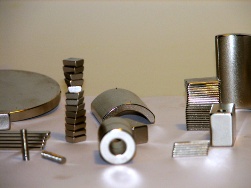 The strongest, most powerful permanent magnet available on the market today are neodymium magnets. They have the chemical formula Nd2Fe14B, and have an exceptional magnetic energy density of up to 512 kJ / m3. If earlier samarium-cobalt (SmCo) magnets were considered the most powerful ones available, then, starting in 1986, they were gradually replaced by neodymium magnets, much more economical in cost of production, albeit with a lower Curie temperature.
The strongest, most powerful permanent magnet available on the market today are neodymium magnets. They have the chemical formula Nd2Fe14B, and have an exceptional magnetic energy density of up to 512 kJ / m3. If earlier samarium-cobalt (SmCo) magnets were considered the most powerful ones available, then, starting in 1986, they were gradually replaced by neodymium magnets, much more economical in cost of production, albeit with a lower Curie temperature.
With the development of the electronics industry, from the 90s to the present, neodymium magnets have gained great popularity everywhere, and many are still surprised by their remarkable properties, because such a magnet can lift a load thousands of times the weight of the magnet itself. It all started with the fact that in 1982 the Japanese company Sumitomo Special Metals, working together with the American General Motors on the search problem ...
5 unusual solar panels of the future
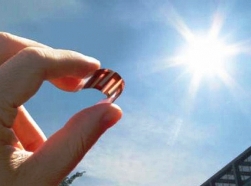 Today, solar panels based on silicon alone are far from the finale on the path to curbing the energy of sunlight and converting it into usable electrical energy. Many works are still being carried out by scientists, and in this article we will consider five unusual solutions that some of the modern researchers are developing.
Today, solar panels based on silicon alone are far from the finale on the path to curbing the energy of sunlight and converting it into usable electrical energy. Many works are still being carried out by scientists, and in this article we will consider five unusual solutions that some of the modern researchers are developing.
In the American National Laboratory of Renewable Energy Sources (NREL), a solar battery based on semiconductor crystals, the sizes of which do not exceed several nanometers, are built up, so-called quantum dots.The sample is already a champion in terms of external and internal quantum efficiency, which amounted to 114% and 130%, respectively. These characteristics show the ratio of the number of generated electron-hole pairs to the number of photons incident on the sample and the ratio of the number of generated electrons...
Plant-e technology - electricity from plants
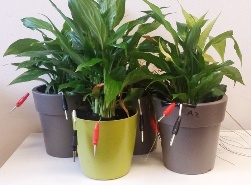 Over the past few years, many companies involved in the development of green energy sources have been conducting painstaking research aimed at finding alternative methods for generating it. So, the Dutch company Plant-e was successful in using for this purpose the by-products of photosynthesis of some water-loving plants.
Over the past few years, many companies involved in the development of green energy sources have been conducting painstaking research aimed at finding alternative methods for generating it. So, the Dutch company Plant-e was successful in using for this purpose the by-products of photosynthesis of some water-loving plants.
The principle of generating electricity is somewhat similar to the well-known school experiment, when the electrodes inserted in potatoes or in lemon allow some electricity to be extracted, however, the technology described here has a more complex device.
The presentation of Plant-e's new technology took place in the autumn of 2014 in a park in Hamburg. The project was called “Starry Sky”, and its essence was that 300 ordinary LED lamps will receive electricity from living plants ...
Superwires - nanotechnology in the electric power industry
 Specialists of the All-Russian Research Institute of Inorganic Materials named after Academician A.A. Bochvara developed the technology for creating the latest super wires. The essence of the technology is the sequential assembly of bimetallic composite billets with their subsequent deformation. This makes it possible to incorporate tape niobium fibers with a thickness of only 6-10 nm into the matrix of an ordinary copper wire.
Specialists of the All-Russian Research Institute of Inorganic Materials named after Academician A.A. Bochvara developed the technology for creating the latest super wires. The essence of the technology is the sequential assembly of bimetallic composite billets with their subsequent deformation. This makes it possible to incorporate tape niobium fibers with a thickness of only 6-10 nm into the matrix of an ordinary copper wire.
The result is a composite wire with a cross section of 2 by 3 mm, in which up to 400 million of these finest niobium fibers are present. The resulting wire is characterized by an anomalously high mechanical strength, significantly more than 500 MPa, and electrical conductivity at the level of 65-85% of the conductivity of pure copper, which is achieved by a small distance between the fibers, comparable with the average path length of the electrons in the copper matrix. Super wires are wires with tensile strength ...
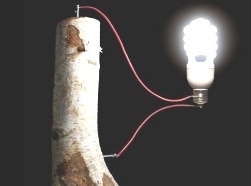 With the development of technologies for the production of low-cost electricity based on solar panels, as well as taking into account significant investment in wind energy, there is a need for a more convenient and technologically intelligent way of storing the received energy. Research results from Linkoping University in Sweden, published in Science, have shown that biological waste paper production can help create affordable, environmentally friendly material for a new type of battery cathode.
With the development of technologies for the production of low-cost electricity based on solar panels, as well as taking into account significant investment in wind energy, there is a need for a more convenient and technologically intelligent way of storing the received energy. Research results from Linkoping University in Sweden, published in Science, have shown that biological waste paper production can help create affordable, environmentally friendly material for a new type of battery cathode.
Inexpensive organic solar cells based on conductive plastic have achieved very high productivity, and the alternative energy obtained in this way on an industrial scale has now become much cheaper, and there is competition justified by progress. Traditionally, metal oxides carry charge in batteries. Commonly used materials, such as cobalt, for example, are a resource ...
Efficiently convert heat to electricity with GMZ Energy
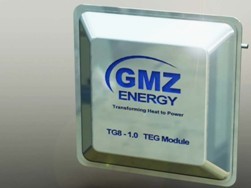 A significant part of the energy, for example, in automobiles, is dissipated in the form of heat in the atmosphere, as a rule, it is irretrievable losses associated, of course, with unnecessary expenses. However, the scientist Gang Chen, who works at the Massachusetts Institute of Technology in Cambridge, USA, has set himself the task of using this wasted waste heat to optimize energy consumption.
A significant part of the energy, for example, in automobiles, is dissipated in the form of heat in the atmosphere, as a rule, it is irretrievable losses associated, of course, with unnecessary expenses. However, the scientist Gang Chen, who works at the Massachusetts Institute of Technology in Cambridge, USA, has set himself the task of using this wasted waste heat to optimize energy consumption.
Traditionally, thermoelectric materials capable of converting the temperature difference into the difference of electric potentials have low energy efficiency, which makes their widespread use impractical. But already in 2004, Gang Chen and Karl Richard Soderbergh, thanks to nanotechnology, significantly improved the efficiency of one of these materials, which made it possible to create more cost-effective thermoelectric devices. In 2008, they improved the thermoelectric converter ...
